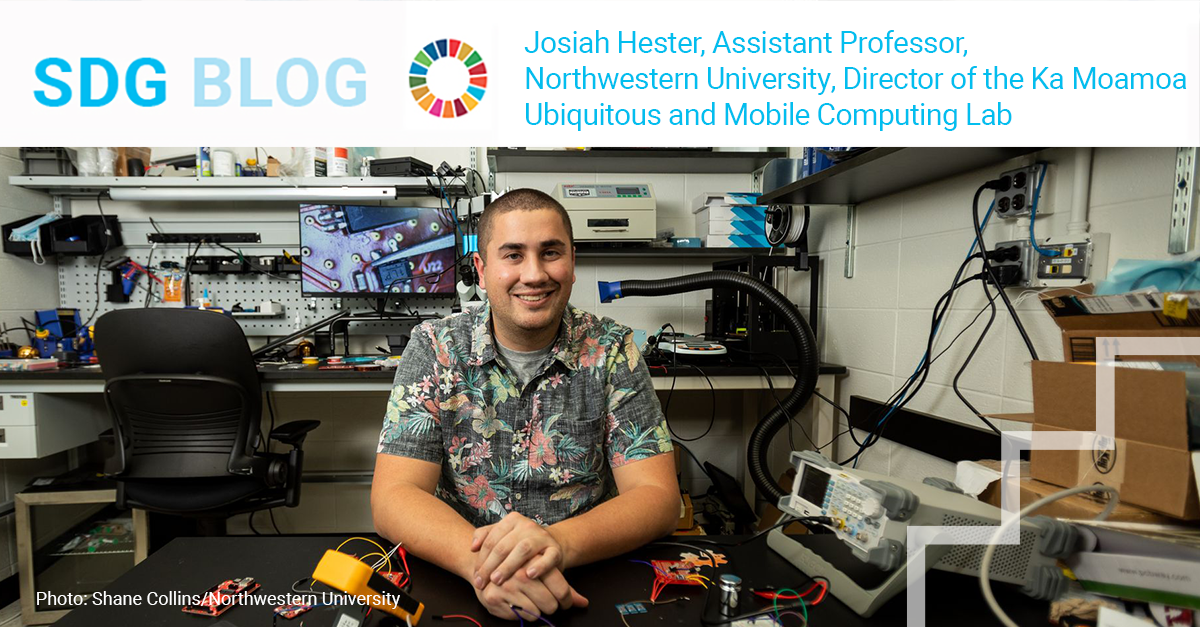SDG Blog

An inclusive vision of computing will help us accelerate progress on the SDGs
By Josiah Hester, Assistant Professor, Northwestern University, and Director of the Ka Moamoa Ubiquitous and Mobile Computing Lab
Computing is all around us — health trackers on wrists, flow sensors on water mains, smart meters on power lines, pedestrian counting cameras in cities – sensors and smart devices are everywhere. This computational fabric is only growing and is crucial for sustainable development. Yet, the current generation of computing devices are not designed for sustainability and longevity, are not accessible, available, or usable outside of developed countries, and are not adaptable for inclusive and community-driven applications. Adding insult to injury, the developed world's endless turnover of perfectly fine electronics for the newer model exacerbates our electronic waste problem. If we hope to meet the Sustainable Development Goals (SDGs), we must first reimagine the Internet-of-Things backbone of sustainable development. We must develop sustainable computational things.
Imagine a bracelet — comfortable, fashionable — that alerts you when your blood oxygen is low, monitors your blood pressure over time, and informs a treatment plan (SDG 3 – Good Health and Wellbeing). Now, think of a wireless sensor node deployed in a city or community, monitoring air quality, weather, and habitat health markers like the presence of pollinators (SDG 15 – Life on Land). The sensor acts as an early warning system for flooding and hazards — as well as provides data for scientists, journalists, and city planners to inform their work (SDG 11 – Sustainable Cities and Communities). These devices are not far-fetched; they exist already– but they are rarely found outside highly developed, high-resource countries.
Why? Because today's devices are not designed for the constraints of sustainable development. Smart devices have short battery lifetimes, require constant recharging or replacement, and rarely last a couple of years. Most devices cannot function without internet connectivity, reliable power grids, and cloud-based service providers (i.e., payment and data brokers). More than a third of the world has never been online, and reliable power is still a problem even in developed countries due to aging infrastructure and extreme weather effects. Finally, the COVID-19 pandemic further exacerbated gaps in connectivity and reliable power. The design of modern smart devices, borne out of a privileged view of the world, barring a vast portion of the global population from the expected benefits of these devices.
But there is a way forward: let's reimagine those examples considering the constraints. Take the bracelet, for example. Instead of using a battery, we can power the device purely by harvesting the mechanical energy generated by the arm swinging while walking. Instead of connecting to the internet, the bracelet computes blood oxygen and blood pressure on the device itself. Without a battery to recharge, the device never has to be taken off, providing rich, continuous data for years.
The other example, an outdoor wireless sensor, can be powered by a small solar panel or by converting microbial activity in the soil into electricity. The sensor forms a network with other sensors just like it. The network alerts cell phones in the community when any sensor detects a hazard (like flooding or drop in air quality). With no batteries to replace, the community can focus on how to best use the data and devices to create a safe, sustainable neighborhood.
When devices no longer need batteries, reliable power grids are not as crucial. When devices don't need to offload tricky calculations to the cloud, internet connectivity and data plans become unnecessary. Unwinding these requirements enables rapid deployment of smart devices to rural and less developed places, reduces the need for maintenance, and enables long-term monitoring applications—for example, sensors for measuring how climate change affects habitat/biodiversity or a wearable for managing chronic hypertension. This is not science fiction. My own work has demonstrated devices that safeguard clinical workers' health by turning a mask into a heart rate tracker that harvests energy from breath, that support environmental justice with soil-powered sensors, and even provide joy with a battery-free clone of a Nintendo Game Boy that runs forever.
This vision of smart devices and computing — one with fewer batteries, with an eye on the embedded carbon costs of computing, and with aims to build computing devices that last for decades, not just years — will have a profound beneficial impact on our ability to meet the SDGs. By lowering the barrier to deploying computing and sensing technology, democratized community-driven efforts become possible. Long-term sensors measure ecosystem diversity, give insights into personal wellness, inform civic action, and provide data to hold governments and businesses to account for pollution and pesticides in our air and water.
As a Native Hawaiian (a member of the Indigenous Polynesian people of the Hawaiian Islands), I was brought up to expect long-term solutions that better steward scarce resources, honor the land, and support the next seven generations. Computing is an essential tool for this. Currently, this tool is inaccessible to most of the world, reducing our global ability to meet our sustainable development goals. Reinventing the tool that is the Internet-of-Things to be sustainable and inclusive is a tall order. Policymakers can encourage longer-term use of electronics, device manufacturers can integrate energy harvesting and optimize for longevity, software developers can extend support for older systems, and development funds can support large-scale deployments. It is a tall order, but it is worth the effort and investment, as these sustainable computational things will serve generations to come.
* The views expressed in this blog are the author’s and do not necessarily reflect the opinion of UN DESA.
 Welcome to the United Nations
Welcome to the United Nations